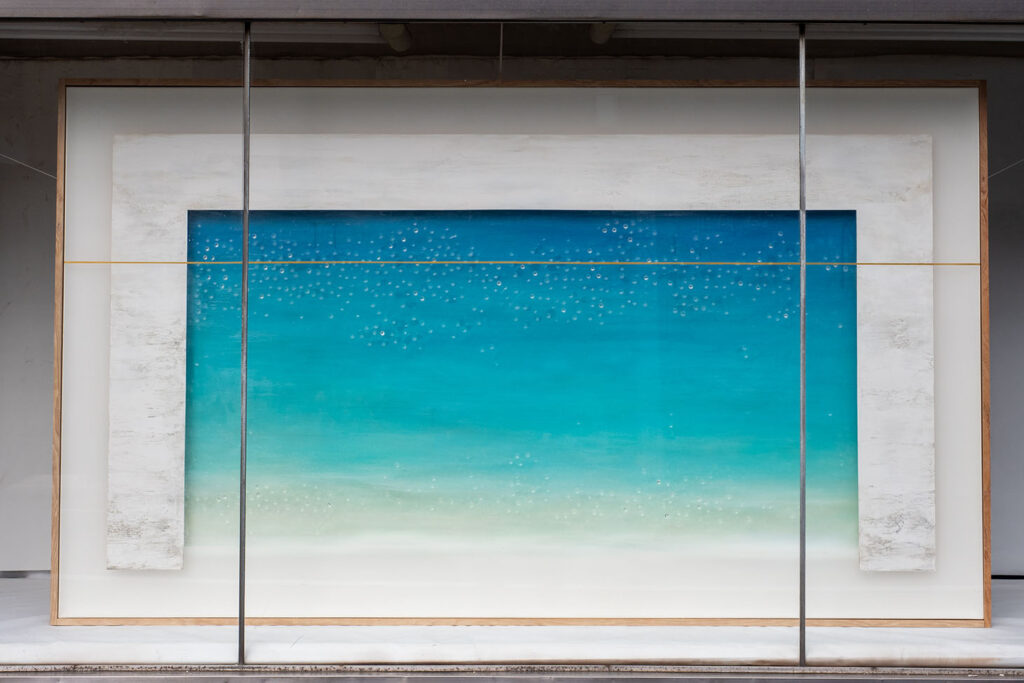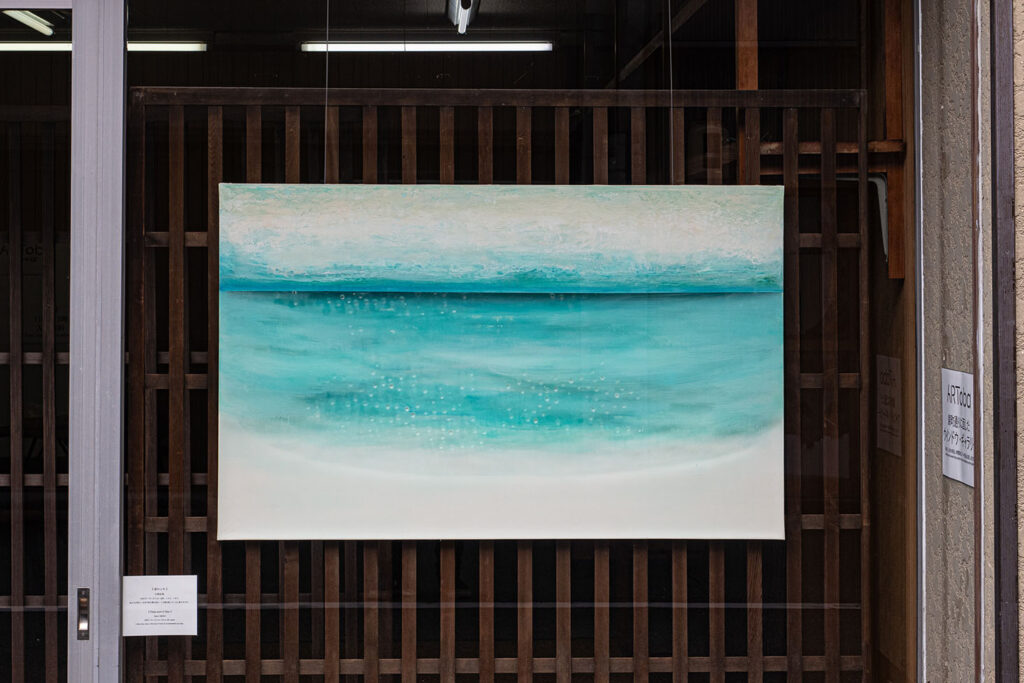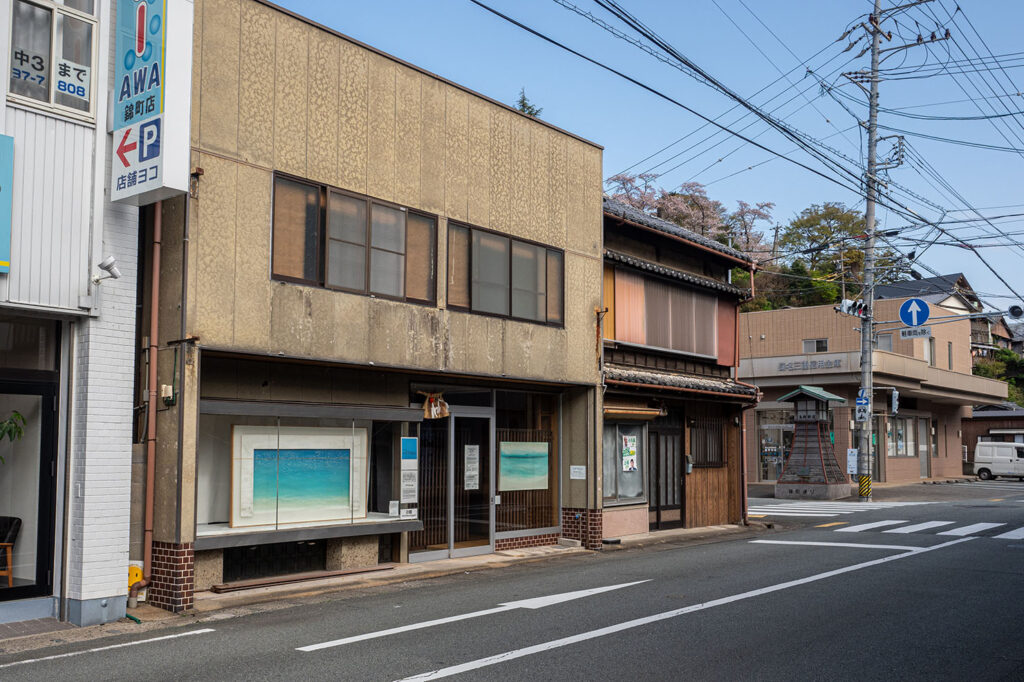大西佐奈 ”Horizontal Time” 評
安井海洋(美術批評)
Bilingual Review. Scroll down for English.

大⻄佐奈《 Surround #h 》、2020年 112 x 194 cm 油彩 シルク パネル
大西佐奈の《Surround #h》の構成は一見して伝わる。それは①画面中央の海波を描いた色面、②それを囲う凹凸のある石のような質感のコの字の色面、③さらにそれを囲う白色の層の三層からなる構成である。絵画に奥行きを与えているのは②を縁取るわずかな陰影のみで、②が画面の手前に浮きあがって見える。
影は描かれたイリュージョンではなく、②の絵具がつくりだした実際の影である。木枠に絹布を張った支持体の向う側が薄く透けて見えているのである。さらにこの絹布は、メディウムを塗布することで透明になる。①はメディウムと絵具を塗ることで透明な海の色を模倣しており、裏面に滲み出たメディウムが水滴となっているのさえ目に入る。
そして、これら①②③を一本の線が横断する。この線だけは海や石など現実の対象を模倣することなく、ただの線として描かれている。レイヤーを越境していくことで、①②③相互の結びつきが生み出すイリュージョンをすべて無化してしまう。このように、作品はレイヤーの重なりとそれを否定する線という、単純にして明快な構成からなるのである。
この明快さは、不要な部分の一切を削り落としたからこそ実現している。画中の空間には三層のレイヤー以外に何もなく、海面の上に白いコの字の石が浮かびあがっているだけである。支持体に関しても、存在感を極力薄めようとしたためか、絹布に皺が寄らないようパネルに張り、折り目も下部の縁にわずかに見せるだけにとどめるなど、丁寧に処理されている。
そしてこれらの要素が形成する空間が、たった一本の線によって無化される。絵画は空間のイリュージョンとその裏切りとの無限の円環を巡るのである。

大⻄佐奈、《 星のふち 》、2020年 73 x 117 cm、 油彩 シルク パネル
一方、《星のふち》においてもメディウムによる絹布の透明化が見られるが、《Surround #h》のような抽象化された線は描かれない。山景から水面に切り替わる境界が線の代わりを演じるものの、それは山と水からなる風景の一部として溶け込んでおり、絵画内の空間を否定するには至らない。こちらの作品はむしろ風景から詩情を醸し出すことを目指しているといえよう。本展では性質の異なる2点の作品が会場のウィンドウに並び、風景の創出とその否定の間で揺れ動く。
画家の田淵安一は自らのエッセイにおいて、「絵を描くこと、それはカンバスから表面を取り払い、視線が区画を逃れる通路をひらくことだ。画面を組織すること、それは視線の予定を狂わすことだ」と語る(「金の弁明」『イデアの結界——西欧的感性のかたち』224頁)。大西の絵画は、表面を取り払い、視線をイリュージョンに導いたかと思えば、次の瞬間には視線を再び表面に引き戻す。この無限の反復に引き込まれて、観者は「視線の予定」をいつまでも狂わされ、見えるものと見えざるものとの狭間にある奈落に落ちていく。

大西佐奈展 「Horizonal Time」ARToba アートスペース、 2021 年 4月4日- 5月27日
安井海洋/YASUI Mihiro: 美術批評、文化史研究。主な著作に「酔う女ー徳田秋聲『新世帯』と明治期における女性の飲酒文化」伊藤信博編『アジア遊学250 酔いの文化史』勉誠出版、2020年、「虚と実のあいだーあいちトリエンナーレ2019における歴史の語り」『芸術批評誌REAR』44号、2020年など。また主な企画展示に、「魂の影 Tracing the soul」プライベイト、2021年5月など。
Sana ONISHI “Horizontal Time” Review
Mihiro YASUI (Art Critic)
The composition of Sana Onishi’s “Surround #h” can be understood at first glance. The composition consists of three layers: ① a colored surface depicting ocean waves in the center of the painting, ② a U-shaped colored surface with an uneven stone-like texture surrounding the center area, and ③ a white layer surrounding that. The only thing that gives the painting depth is the slight shadow framing ②, which appears to float on the foreground of the picture.
The shadows are not painted illusions, but actual shadows created by the paint in ②. The support, which is a silk cloth stretched over a wooden frame, appears to be thinly transparent. In addition, this silk cloth becomes more transparent when medium is applied. ① imitates the color of the transparent sea by applying medium and paint, and we can even see water droplets of medium seeping out from the back of the painting.
Then, a single line crosses these ①, ②, and ③. This line does not mimic any real object, such as the sea or stone, but is simply painted as a line. By crossing the layers, all the illusions created by the interconnection of ①, ②, and ③ are neutralized. In this way, the work consists of a simple and clear composition of overlapping layers and a line that negates them.
The clarity is achieved by eliminating all unnecessary elements. There is nothing but three layers of space in the painting, with a white U-shaped stone form floating on the surface of the sea. As for the support, perhaps in an attempt to reduce the sense of presence as much as possible, the silk cloth is stretched over the panel so that it does not wrinkle, and the folds are only slightly visible at the bottom edge.
The space formed by these elements is rendered meaningless by the single line. The painting is an infinite circle of spatial illusions and their betrayal.
On the other hand, in the artwork, “Deep pool of Star,” the silk cloth is made transparent by the medium, but there is no abstracted line as in “Surround #h”. The boundary between the mountain landscape and the water surface takes the place of the line, but it blends in as part of the landscape consisting of mountains and water, and does not negate the space within the painting. It can be said that this work rather aims to evoke poetic sentiment from the landscape. In this exhibition, two works with different characteristics are displayed together in the windows of the exhibition space, oscillating between the creation of landscape and its denial.
In his essay, the artist Yasse Tabuchi wrote, “To paint is to remove the surface from the canvas, to open a passage for the eye to escape boundaries. To organize the picture plane is to disrupt the movement of the gaze” (*”Apologia of Gold,” in The Boundaries of Ideas: The Shape of Western Sensibility, p. 224). Onishi’s paintings remove the surface and lead the viewer’s gaze into an illusion, only to pull the viewer’s gaze back to the surface the next moment. Drawn into this infinite repetition, the viewer’s “gaze movement” is forever disrupted, and he or she falls into the abyss between the visible and the invisible.
*English translation of the title of text by Yasse (Yasukazu) Tabuchi: “‘Kin no benmei’, idea no kekkai” — seiō teki kansei no katachi”
Sana ONISHI Exhibition “Horizonal Time“, ARToba Art Space, 4 April (Sun) – 27 May (Thu) 2021
Mihiro YASUI: Art critic and cultural history researcher.

